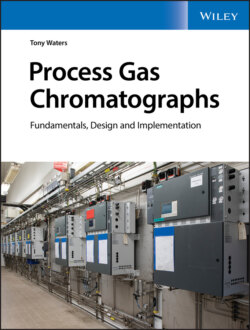Читать книгу Process Gas Chromatographs - Tony Waters - Страница 73
The answer
ОглавлениеFigure 3.3 is also the correct answer for the chromatogram you were invited to draw on Figure 3.2. The four peaks are centered at 3, 4, 6, and 12 minutes from sample injection. You may find this surprising; the peaks are no longer equally spaced! Let's see how that happened.
In Figure 3.1, none of the peaks have left the column yet, so your chromatogram needs to show a flat baseline for the first three minutes after injection – the so‐called “dead time.” It would be a mistake to draw any peaks in this zone.
The air peak is just leaving the column after three minutes of traveling. Since it doesn't dissolve in the liquid phase, its time in the liquid phase is zero. One way to indicate this is to show its gas:liquid residence time ratio as 3:0. Since the air molecules are not delayed in the liquid phase, the air peak should be very narrow, and it's reasonable to draw it centered at three minutes.
Most people find it very difficult to decide where the other peaks come out on the chromatogram, perhaps because the correct answer defies all expectations.
Actually, it's easy to get it right. Starting from the position of each peak in Figure 3.1, there are two ways of reaching the correct conclusion about its final position on the chromatogram. Both ways are noted below.
To locate the remaining peaks, it's easier to think about them in the following order, starting with the propane peak.
The propane peak took three minutes to reach the center of the column, so it should take another three minutes to reach the detector, for a retention time of six minutes overall. A better argument comes from its solubility ratio. Recall that retention time is the sum of the time a component spends in the gas phase and the time it spends in the liquid phase (Equation 3.2). To reach the detector, the propane peak must spend three minutes traveling in the gas phase. But, because of its 50:50 solubility ratio, it also spends three minutes stopped in the liquid – so its residence time ratio is 3:3 for a total retention time of six minutes.
The 1‐butene peak took three minutes to move 25 % of the column length, so it should take four times as long to reach the detector, for a retention time of twelve minutes overall. A better argument invokes its solubility ratio. To reach the detector, the 1‐butene peak must spend three minutes traveling in the gas phase. But, because of its 25:75 solubility ratio, it also spends nine minutes stopped in the liquid – so its residence time ratio is 3:9 for a total retention time of twelve minutes.
The carbon dioxide peak took three minutes to move 75 % of the column length, so it should take one additional minute to travel the last 25 % of the column, for a retention time of four minutes overall. A better argument comes from its solubility ratio. To reach the detector, the carbon dioxide peak must spend three minutes traveling in the gas phase. But, because of its 75:25 solubility ratio, it also spends one minute stopped in the liquid – so its residence time ratio is 3:1 for a total retention time of four minutes.
Notice that the different molecules all spend exactly three minutes in the gas phase traveling.
Notice also that the peaks were equally spaced along the column, but not on the chromatogram. This may seem strange, but it's the normal behavior of columns and explains why early peaks tend to cluster close to the air peak location, while later ones have much longer retention times. In the next chapter, we'll look at these patterns of retention in more detail.
If you closely followed what is going on here, you may be thinking that the pressure drop along the column must distort the predictions made in the above arguments. That's somewhat true, but way too complex to consider at this early stage.
